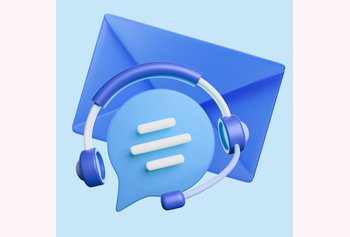

If you’re running a business, you’d know that occasional disruptions to your products or services are inevitable.
Sometimes these interruptions are planned, while other times they arise unexpectedly. No matter the cause, what matters is keeping all the stakeholders informed and on the same page.
This is where effective communication comes into play – setting clear expectations and providing reassurance.
Often, it’s the responsibility of the IT Service Management (ITSM) department to keep everyone in loop about a downtime.
But, how can your ITSM team write effective emails that informs, reassures, and guides stakeholders during a downtime?
In this article, we’ll discuss the importance of downtime communication, best practices, and provide 10 sample ITSM email templates for scheduled downtime.
Deliver Fast and Exceptional IT Service See how Hiver worksITSM needs to effectively communicate about downtime, because:
Stakeholders, be it customers, employees, or partners, value transparency. By communicating about the downtime promptly and clearly, businesses can build trust, even in challenging situations.
When stakeholders are aware of the downtime and the expected time of resolution, they can make informed decisions. For instance, a customer might decide to come back later to make a purchase if they know when the platform will be back online.
Here are the best practices for an effective downtime email notification:
Here are 10 sample IT Service Management (ITSM) email templates for different downtime scenarios:
A Routine Maintenance Notification is used to inform stakeholders about planned maintenance activities that might affect the availability, performance, or functionality of IT services or systems.
Subject: Scheduled IT Maintenance Notification for [Service/System Name] on [Date]
Dear [Recipient Name/All Users],
We would like to inform you about an upcoming routine maintenance activity scheduled for our [Service/System Name].
Details of the Maintenance:
– Date: [Specific Date]
– Start Time: [Start Time] [Timezone]
– End Time: [End Time] [Timezone]
– Expected Downtime: [e.g., 2 hours]
This routine maintenance is necessary to [briefly describe the reason, e.g., “upgrade our servers for better performance and security.”]
During the maintenance window, [Service/System Name] will be unavailable. Please ensure that you save any work and log out of the system before the maintenance begins.
Alternative Solutions/Workarounds (if any):
[e.g., “You can access the archived data through our backup portal at [Backup Portal Link].”]
– Plan your activities accordingly to avoid disruption.
– In case you have tasks that rely on [Service/System Name], consider rescheduling them or completing them ahead of the maintenance window.
For any queries, concerns, or further clarification, please reach out to our IT Support team at [Support Email] or [Support Phone Number].
Thank you for your patience and support.
[Your Name]
[Your Position]
[Company/Organization Name]
[Contact Details]
An Extended Downtime Alert is sent out when a system or service outage surpasses its originally expected downtime. Such instances can occur due to unforeseen complications during a maintenance event, unexpected system failures, or other unplanned incidents.
Subject: Important Alert: Extended Downtime for [Service/System Name]
Dear [Recipient Name/All Users],
We regret to inform you that the [Service/System Name] will be unavailable for longer than initially anticipated.
Details of the Extended Downtime:
– Original End Time: [Original End Time] [Timezone]
– New Estimated End Time: [New End Time] [Timezone]
– Reason for Extension: [e.g., “An unexpected issue encountered during our routine maintenance.”]
Due to this extension, [Service/System Name] will remain inaccessible until the new estimated end time. We recognize the inconvenience this might cause and assure you that our team is working diligently to restore services as soon as possible.
– Please continue to save any associated work externally and avoid using the system until further notice.
– If you have tasks contingent on [Service/System Name], we recommend exploring alternate approaches or postponing them until services are restored.
For any immediate concerns or queries, do not hesitate to contact our IT Support team at [Support Email] or [Support Phone Number].
We genuinely apologize for this unexpected delay and appreciate your patience and understanding during this time.
Thank you for your continued support.
Best regards,
[Your Name]
[Your Position]
[Company/Organization Name]
[Contact Details]
A Postponed Maintenance Update is conveyed when a previously scheduled maintenance event has been postponed to a later date or time. Such postponements can arise due to various reasons such as the availability of resources, unforeseen high-priority incidents, or logistical issues that might hamper the success of the planned maintenance.
Subject: Update: Postponed Maintenance for [Service/System Name]
Dear [Recipient Name/All Users],
We are reaching out to inform you that the previously scheduled maintenance for [Service/System Name] has been postponed.
Original Maintenance Schedule:
– Date: [Original Date]
– Start Time: [Original Start Time] [Timezone]
– End Time: [Original End Time] [Timezone]
Reason for Postponement: [e.g., “Due to a high-priority incident that needs our immediate attention.”]
At this time, we are working on finalizing a new date and time for the maintenance. We will communicate the updated schedule as soon as it’s established.
The good news is that [Service/System Name] will remain fully operational and accessible during the original maintenance window. No immediate actions are required on your end.
We understand that you might have adjusted your plans based on the original maintenance schedule, and we deeply apologize for any inconvenience this postponement might cause.
For any questions or further clarifications, please don’t hesitate to reach out to our IT Support team at [Support Email] or [Support Phone Number].
Thank you for your patience, understanding, and continued support.
Warm regards,
[Your Name]
[Your Position]
[Company/Organization Name]
[Contact Details]
A Downtime Completion Confirmation is communicated once a scheduled or unscheduled service/system downtime has concluded and normal operations have resumed. This notification serves to inform stakeholders that they can now access and utilize the system or service as usual.
Subject: [Service/System Name] Maintenance Complete – System Now Operational
Dear [Recipient Name/All Users],
We are pleased to inform you that the maintenance/downtime for [Service/System Name] has been successfully completed, and the system is now fully operational.
Brief Recap:
Maintenance Duration:
– Start Time: [Start Time] [Timezone]
– End Time: [End Time] [Timezone]
Reason for Downtime: [e.g., “To implement essential system upgrades for enhanced performance.”]
– [Any important notes/instructions, e.g., “Please clear your browser cache before accessing the system to ensure optimal performance.”]
– [Another note if needed, e.g., “For users who access via the mobile app, please ensure your app is updated to the latest version from the app store.”]
Should you encounter any issues or irregularities after this maintenance, please report them immediately to our IT Support team at [Support Email] or [Support Phone Number]. Your feedback is invaluable to ensure the continued stability and functionality of [Service/System Name].
We truly appreciate your patience and cooperation during this necessary downtime. We continually strive to improve our services and minimize disruptions to better serve you.
Thank you for your understanding and continued support.
Best wishes,
[Your Name]
[Your Position]
[Company/Organization Name]
[Contact Details]

An Unplanned Downtime Notification is conveyed when an unexpected event or issue causes an interruption in service or system availability. Unlike scheduled maintenance or planned downtime, which users are typically made aware of in advance, unplanned downtimes occur without warning. They could be due to factors like software bugs, hardware failures, network issues, cyber attacks, or other unforeseen complications.
Subject: Urgent Alert: Unplanned Downtime for [Service/System Name]
Dear [Recipient Name/All Users],
We regret to inform you that [Service/System Name] is currently experiencing an unplanned outage.
Details of the Issue:
– Time Detected: [Time] [Timezone]
– Description: [Brief description if available, e.g., “We’ve identified a network connectivity issue affecting user access.”]
– Estimated Resolution Time: [e.g., “Our teams are working on it and anticipate a resolution within 3 hours.” or “Currently being assessed.”]
Impact:
During this period, [Service/System Name] will be inaccessible. We understand the criticality of this service to your operations and deeply regret the inconvenience.
– [Any actionable advice, e.g., “Please refrain from attempting multiple logins during this time.”]
– [Another piece of advice, e.g., “For urgent tasks, please utilize our backup system or portal.”]
Our technical team is actively working to resolve this issue as quickly as possible. We will keep you updated with any significant developments and notify you once the system is restored.
For any urgent queries or concerns, please reach out to our IT Support team at [Support Email] or [Support Phone Number].
We sincerely apologize for this unexpected interruption and appreciate your patience and understanding during this time.
Best regards,
[Your Name]
[Your Position]
[Company/Organization Name]
[Contact Details]
A Downtime Rescheduled Notification is disseminated when a previously announced maintenance or planned downtime has been rescheduled to a new date or time. Reasons for such rescheduling can vary, from resource constraints to the emergence of high-priority incidents, or even feedback from stakeholders that the chosen time is inconvenient.
Subject: Rescheduling Alert: Downtime for [Service/System Name]
Dear [Recipient Name/All Users],
We wish to inform you of a change in the scheduled downtime for [Service/System Name].
Original Maintenance Schedule:
– Date: [Original Date]
– Start Time: [Original Start Time] [Timezone]
– End Time: [Original End Time] [Timezone]
New Maintenance Schedule:
– Date: [New Date]
– Start Time: [New Start Time] [Timezone]
– End Time: [New End Time] [Timezone]
Reason for Rescheduling: [e.g., “Due to an unforeseen operational challenge, we found it best to shift the maintenance to a more suitable timeframe.”]
Downtime Impact:
During the new maintenance window, [Service/System Name] will be temporarily unavailable. [Any specific impacts or workarounds, e.g., “Please ensure you save your work before this time. Offline modes will still be operational.”]
We recognize the potential adjustments you might have made based on the initial schedule and sincerely apologize for any inconvenience this rescheduling may cause.
For any further inquiries or feedback, please reach out to our IT Support team at [Support Email] or [Support Phone Number].
Your understanding and flexibility are greatly appreciated as we work towards improving and sustaining our services.
Warm regards,
[Your Name]
[Your Position]
[Company/Organization Name]
[Contact Details]
A Downtime Extension Update is disseminated when an ongoing maintenance or planned downtime requires more time to complete than initially projected. This could be due to unforeseen complications, unexpected findings during the maintenance, or other issues that arise, causing delays.
Subject: Important Update: Extended Downtime for [Service/System Name]
Dear [Recipient Name/All Users],
We regret to inform you that the ongoing maintenance for [Service/System Name] requires additional time and will extend beyond the originally projected completion time.
Details of the Extension:
– Original Expected End Time: [Original End Time] [Timezone]
– New Estimated End Time: [New Extended End Time] [Timezone]
Reason for Extension: [e.g., “During the maintenance, we encountered an unexpected issue requiring additional attention to ensure the system’s stability.”]
Impact and Recommendations:
– [Service/System Name] will remain inaccessible until the new estimated end time.
– [Specific advice, e.g., “We advise you to continue saving any related work externally and refrain from attempting to access the system until further notice.”]
Our team is diligently working to complete the necessary tasks and restore the service as quickly and safely as possible. We sincerely apologize for this extension and understand the inconvenience it might pose.
For immediate concerns or questions, please contact our IT Support team at [Support Email] or [Support Phone Number].
Your patience and understanding during this time are invaluable to us. We remain committed to providing you with the best service experience possible.
[Your Name]
[Your Position]
[Company/Organization Name]
[Contact Details]
A Downtime Cause Explanation is issued after an unplanned service or system interruption has occurred and been resolved. The primary purpose of this communication is to provide stakeholders with a clear understanding of the root cause of the incident, the steps taken to address it, and measures being implemented to prevent recurrence.
Subject: Explanation & Analysis: Recent Downtime of [Service/System Name]
Dear [Recipient Name/All Users],
We are writing to provide clarity on the recent unexpected downtime experienced with [Service/System Name] on [Date].
– Start Time of Downtime: [Start Time] [Timezone]
– End Time of Downtime: [End Time] [Timezone]
– Total Duration: [Duration, e.g., “2 hours”]
Root Cause:
[Detailed but concise explanation, e.g., “A firmware bug in one of our central servers caused a chain reaction, leading to system-wide access disruptions.”]
– [Step 1 taken to address the issue, e.g., “The affected server was promptly isolated.”]
– [Step 2, e.g., “A rollback to the previous stable firmware version was executed.”]
– [Any additional steps or actions.]
To prevent a recurrence of such an incident, we are:
– [Preventive action 1, e.g., “Conducting a thorough audit of all firmware updates before deployment.”]
– [Preventive action 2, e.g., “Enhancing our system monitoring capabilities to detect and address anomalies faster.”]
– [Any other preventive measures or improvements.]
We deeply regret the inconvenience and disruptions you faced due to this downtime. Our team is committed to not only rectifying such incidents but also learning from them to enhance our systems and services.
Should you have further questions or concerns regarding this incident, please feel free to contact our IT Support team at [Support Email] or [Support Phone Number].
Thank you for your understanding, patience, and continued trust in our services.
Sincerely,
[Your Name]
[Your Position]
[Company/Organization Name]
[Contact Details]
An Emergency Maintenance Alert is a notification disseminated when there’s an urgent need to perform immediate system or service maintenance. This type of maintenance often arises from unforeseen issues that could severely impact business operations, data integrity, or system security if not promptly addressed. Unlike regular maintenance, which is scheduled well in advance, emergency maintenance may give stakeholders little to no notice.
Subject: URGENT: Emergency Maintenance Notice for [Service/System Name]
Dear [Recipient Name/All Users],
Due to an emergent issue, we must conduct critical maintenance on [Service/System Name] to ensure its continued stability and security.
Details of the Emergency:
– Start Time: [Time] [Timezone], [Immediate/As of now/In the next hour]
– Estimated Duration: [e.g., “Approximately 3 hours” or “Currently uncertain; updates will follow.”]
Reason for Emergency Maintenance:
[e.g., “We’ve detected a critical vulnerability that poses potential risks to our system’s security.”]
Impact:
During this maintenance window, [Service/System Name] may be intermittently unavailable or experience degraded performance. [Any other specific impacts, e.g., “Users logged in might be disconnected.”]
– [Actionable advice, e.g., “Please save all ongoing work and log off from the system.”]
– [Another piece of advice, e.g., “Avoid initiating new tasks until the maintenance is complete.”]
Our dedicated technical team is working diligently to address this issue with minimal disruption. We understand the challenges sudden maintenance can pose and deeply regret the inconvenience.
For urgent queries or immediate assistance, kindly contact our IT Support team at [Support Email] or [Support Phone Number].
Thank you for your patience and understanding during this crucial time. We prioritize the security and reliability of our services, and this maintenance aims to uphold that commitment.
[Your Name]
[Your Position]
[Company/Organization Name]
[Contact Details]
A Maintenance Reminder is a follow-up communication sent out as the scheduled maintenance window approaches. Its primary purpose is to reinforce the initial notification and ensure stakeholders are adequately prepared for the upcoming downtime.
Subject: Reminder: Upcoming Maintenance for [Service/System Name] on [Date]
Dear [Recipient Name/All Users],
This is a friendly reminder regarding the scheduled maintenance for [Service/System Name], as previously communicated.
– Date: [Date]
– Start Time: [Start Time] [Timezone]
– Estimated End Time: [End Time] [Timezone]
Purpose:
[e.g., “This maintenance aims to upgrade our system’s infrastructure, ensuring improved performance and enhanced security features.”]
– [Service/System Name] will be temporarily unavailable during the maintenance window.
– [Any other impacts, e.g., “Certain functionalities might be limited post-maintenance until full restoration.”]
– [e.g., “Please ensure all your ongoing tasks related to the system are saved and closed before the maintenance starts.”]
– [Another advice, e.g., “Consider scheduling tasks that rely on this system outside of the maintenance window.”]
We appreciate your understanding and cooperation in helping us maintain a reliable and secure service environment. If you have further questions or need assistance in preparing for this maintenance, please reach out to our IT Support team at [Support Email] or [Support Phone Number].
Thank you for your continuous support and patience.
Best regards,
[Your Name]
[Your Position]
[Company/Organization Name]
[Contact Details]
Transparency in ITSM does more than just keep everyone in the loop. It cultivates trust, establishes credibility, and ensures stakeholders feel valued and informed.
These email templates help you do just that – ensuring alignment between IT teams and their audiences, be it internal or external.
However, as with all tools and templates, it’s essential to remember that one size doesn’t fit all. Regular evaluation and refinement of communication best practices will ensure these templates remain effective, relevant, and resonant with your audience.
A passionate content marketer, Nidhi writes value-driven, actionable content for various teams such as customer service, finance, IT and HR. Her expertise lies in helping these teams engage, collaborate, and manage their workload better - by shedding insights on best practices and industry trends. When not working, you'll find her tuning in to marketing and support-related podcasts, while also planning her next vacation.


Gmail for Business is a powerful email service. Learn about its standout features, pricing, and setup.

Have you ever received cold emails or emails from your peers with grammatical errors, spelling mistakes, misspelled names, the.

Email has become an integral part of how companies communicate and collaborate. But with the average person receiving around 100-120 emails per day, it can be tough to stay on top.